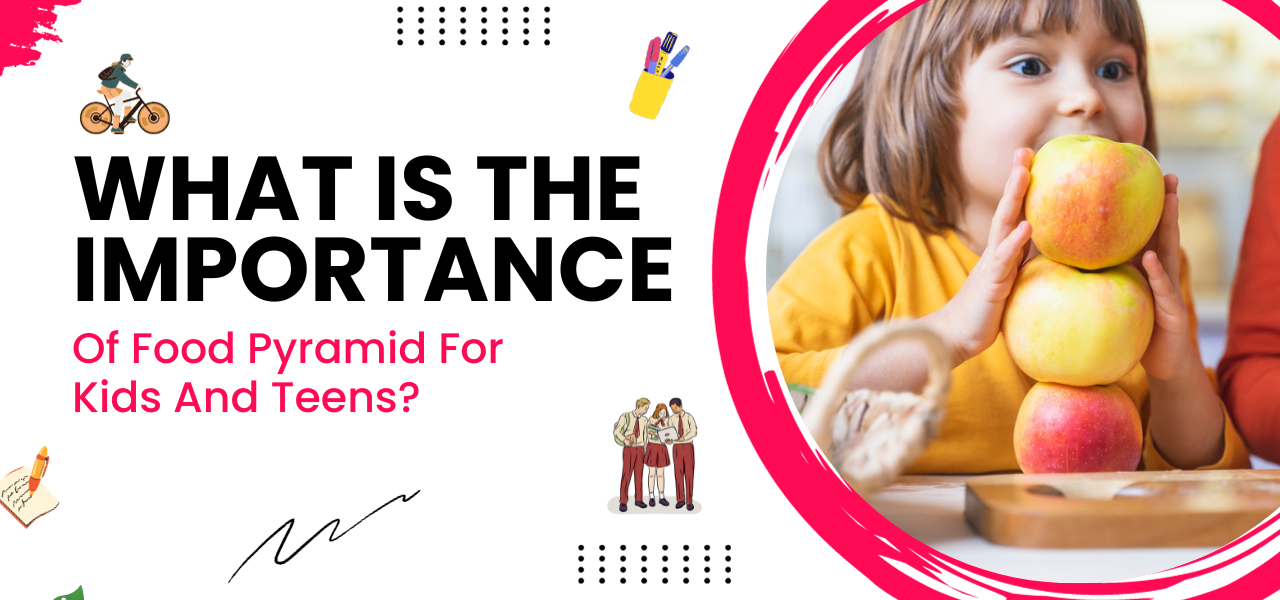Understanding the Significance of the Food Pyramid for Kids and Teens
The food pyramid for teenager and kids stands as a visual representation of the recommended daily intake of various food groups essential for maintaining a balanced diet. It serves as a vital tool in educating children and teenagers about healthy eating habits.
Importance of the Food Pyramid for Teenager and Kids
1. Promoting Nutritional Balance
- Essential Nutrients: The food pyramid emphasizes the importance of consuming diverse food groups, ensuring adequate intake of essential nutrients like vitamins, minerals, carbohydrates, proteins, and fats.
- Growth and Development: For kids and teenagers, a balanced diet supports proper growth, development, and overall health, providing the necessary fuel for physical and cognitive functions.
2. Establishing Healthy Eating Patterns
- Portion Control: The pyramid outlines recommended portion sizes for each food group, instilling the concept of portion control, preventing overconsumption or undernutrition.
- Diverse Choices: Encouraging a variety of foods within each group promotes diverse food choices, preventing monotony and ensuring a wider range of nutrient intake.
3. Preventing Health Issues
- Obesity and Malnutrition: Following the food pyramid can help combat obesity by encouraging healthier food choices and prevent malnutrition by ensuring adequate nutrient intake.
- Reducing Risks: It assists in reducing the risk of chronic diseases later in life by establishing healthy eating habits early on.
The Food Pyramid’s Structure: A Guideline for Kids and Teens
The food pyramid typically comprises five major food groups, let’s check the food pyramid for teenager and kids:
- Grains: Provides energy and fiber.
- Vegetables: Rich in vitamins, minerals, and fiber.
- Fruits: Source of vitamins, minerals, and antioxidants.
- Dairy: Offers calcium and other essential nutrients for bone health.
- Proteins: Includes meat, poultry, fish, legumes, and nuts, crucial for growth and repair.
Creative Tips for Applying the Food Pyramid
- Meal Planning: Involve kids and teens in meal planning, encouraging them to choose from each food group when preparing meals.
- Educational Activities: Utilize games, puzzles, or interactive sessions to teach about the food pyramid, making learning about nutrition fun and engaging.
Addressing the Common Concerns and Misconceptions About the Food Pyramid
1. Myths vs. Facts:
- Myth: The food pyramid restricts certain foods entirely.
- Fact: The pyramid emphasizes moderation and variety rather than strict prohibition.
- Myth: It’s complicated and challenging to follow the food pyramid.
- Fact: With simple guidelines and creative approaches, incorporating the food pyramid into daily meals becomes more manageable.
2. Tailoring to Individual Needs:
- Vegetarian and Vegan Adaptation: For those following vegetarian or vegan diets, the food pyramid can be adjusted to include plant-based alternatives rich in necessary nutrients.
- Allergies and Dietary Restrictions: The food pyramid can accommodate various dietary restrictions by substituting suitable alternatives within each food group.
Practical Application of the Food Pyramid
1. Planning Meals and Snacks:
- Balanced Breakfast: Incorporate grains, fruits, dairy, or alternatives in breakfast options like whole-grain cereal with milk and a side of fruits.
- Nutrient-Rich Lunch: Build a balanced lunchbox containing vegetables, lean proteins, whole grains, and a serving of dairy or its alternatives.
2. Interactive Learning and Activities:
- DIY Food Pyramid: Engage kids and teens in creating their version of the food pyramid using pictures or drawings of various foods in each group.
- Cooking Challenges: Organize cooking challenges or family cooking nights where each member prepares a dish representing different food groups.
Tailoring the Food Pyramid for Teenager & Kids:
- Independence and Decision-Making: Encourage teenagers to make informed food choices based on the food pyramid’s guidelines, fostering independence in meal decisions.
- Educating on Nutritional Requirements: Help teens understand their nutritional needs and how the food pyramid assists in meeting these needs during crucial developmental stages.
Incorporating Tech and Visual Aids:
- Interactive Apps and Tools: Utilize mobile apps or online resources that illustrate the food pyramid, making learning about nutrition interactive and engaging.
- Visual Aids at Home: Display charts or posters of the food pyramid in kitchens or dining areas as visual reminders of balanced nutrition.
Food Pyramid and Teenagers’ Lifestyle Changes:
- Impact of Social Influences: Educate teenagers about making mindful food choices when eating out or participating in social gatherings.
- Adapting to Changing Preferences: Support teens in exploring various foods and flavors within each food group, catering to evolving tastes and preferences.
Encouraging a Balanced Approach
1. Encouraging Positive Eating Habits:
- Role Modeling: Adults can set an example by following the food pyramid themselves, reinforcing the importance of balanced nutrition.
- Positive Reinforcement: Celebrate achievements when kids and teens make healthy food choices, creating positive associations with nutritious foods.
2. Teaching Portion Awareness:
- Portion Control Tips: Educate kids and teens about portion sizes, using visuals or everyday objects as references for appropriate portions.
- Mindful Eating Practices: Encourage mindful eating, focusing on enjoying food and recognizing hunger cues to prevent overeating.
Nutrition Education in School Settings
1. Integrating Nutrition Education:
- Curriculum Integration: Incorporate lessons about the food pyramid and balanced nutrition into school curriculums, making it a fundamental aspect of education.
- Hands-On Activities: Organize interactive activities like cooking classes or garden projects to teach kids and teens about food groups and their benefits.
2. School Cafeteria Initiatives:
- Healthier Meal Options: Collaborate with school cafeterias to ensure menu offerings align with the food pyramid, providing balanced and nutritious meals for students.
- Educational Displays: Display posters or signage illustrating the food pyramid in school cafeterias to reinforce its principles among students.
Supporting Parents and Caregivers
1. Educational Resources:
- Online Guides and Articles: Provide access to online resources, articles, and guides—like those available on Parentology—to support parents in understanding and implementing the food pyramid.
- Parental Workshops: Conduct workshops or webinars addressing the importance of the food pyramid and offering practical tips for implementation at home.
2. Family Engagement in Nutrition:
- Family Mealtime: Encourage regular family meals where everyone contributes to preparing and enjoying balanced meals together.
- Grocery Shopping Involvement: Involve kids and teens in grocery shopping, teaching them to identify food groups and make informed choices.
Monitoring and Adapting Nutrition Plans
1. Regular Check-ins:
- Periodic Assessments: Monitor kids’ and teens’ eating habits periodically, making necessary adjustments to ensure adherence to the food pyramid’s principles.
- Consulting Professionals: Seek guidance from nutritionists or pediatricians for tailored advice regarding individual nutritional needs or concerns.
2. Flexibility and Moderation:
- Occasional Treats: Allow for occasional indulgences or treats within a balanced diet, promoting a healthy relationship with food and preventing feelings of deprivation.
- Adapting to Preferences: Respect evolving tastes and preferences by offering alternatives within each food group, ensuring adherence to the pyramid’s principles.
FAQs About the Food Pyramid for Teenager and Kids
Q 1. What age group does the food pyramid apply to?
Ans 1: The food pyramid guidelines are suitable for children and teenagers aged 2 to 18 years.
Q 2. How often should kids refer to the food pyramid for meal planning?
Ans 2: Regularly referencing the food pyramid can aid in creating balanced meal plans, but it’s essential to encourage varied choices within each group.
Q 3. Are there any specific foods to avoid based on the food pyramid?
Ans 3: The food pyramid doesn’t explicitly prohibit foods but encourages moderation, focusing on healthier choices within each group.
Q 4. Can the food pyramid be adapted for dietary restrictions or allergies?
Ans 4: Yes, it can be adjusted by choosing alternatives within each group that cater to specific dietary needs or allergies.
Q 5. Is it necessary to strictly follow the food pyramid’s recommendations?
Ans 5: While it’s a valuable guide, flexibility within the recommendations allows for individual preferences and cultural differences.
Q 6. Can the food pyramid assist in weight management for teenagers?
Ans 6: Yes, by promoting a balanced diet, the food pyramid aids in maintaining a healthy weight for teenagers.
Q 7. How can parents encourage adherence to the food pyramid’s recommendations?
Ans 7: Leading by example, involving kids in meal planning, and offering a variety of nutritious foods can encourage adherence.
Q 8. Should supplements be used to fulfill nutrient requirements outlined in the food pyramid?
Ans 8: Ideally, nutrients should come from food. Supplements should only be considered under professional guidance.
Q 9. Are there any disadvantages to following the food pyramid?
Ans 9: Overly rigid adherence without flexibility or individual considerations could limit dietary variety.
Q 10. How can the food pyramid contribute to teenagers’ mental health?
Ans 10: A balanced diet can positively impact mental health, promoting overall well-being and mood stability.
Conclusion: Empowering Healthy Choices
The food pyramid for teenager and kids serves as a foundational tool in guiding children and teenagers towards a balanced and nutritious diet. By dispelling myths, providing practical applications, and tailoring guidelines to individual needs, it becomes an empowering tool for families and educators in instilling healthy eating habits. Encouraging creativity and adaptability fosters a positive relationship with food, ensuring kids and teens grow up to make informed and healthy dietary choices.
For further insights into children’s nutrition and lifestyle, explore the range of resources available at Parentology, dedicated to supporting families in fostering healthy and well-rounded lifestyles.





